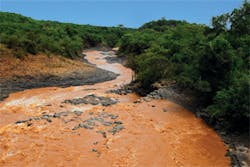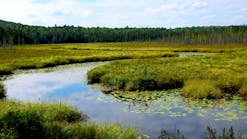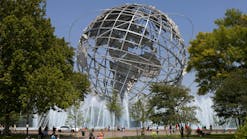Softer Approaches
Over the past two decades or so, most of the states on the Atlantic, Gulf of Mexico, and Pacific coasts have adopted plans designed to manage coastal erosion on a more long-term basis. Many encourage a more natural approach to defending the beaches.
“The closer we come to developing more natural solutions for shoreline erosion problems, the more self-sustaining any such system will be,” says Griggs.
“In Rhode Island, we prefer to let nature play out,” relates Freedman. “One of the goals of the Coastal Resources Management Council is to preserve the beaches. The best way to do this is to keep natural systems going. In the long run, you’re not going to win against the waves. Many shoreline protective structures built in the past are now in various states of disrepair as the sea begins reclaiming these areas.”
Eliminating Hard Structures
Some states prohibit the use of hard structures to protect oceanfront property. One of them is Maine, which prohibits new sea walls, groins, jetties, and other armor on its beaches. “More and more, people are recognizing that engineered structures aren’t the way to go because they contribute to the problem by increasing erosion farther down the coast,” observes Stephen Dickson, a marine geologist with the Maine Geological Survey.
North Carolina also bans the use of engineered structures to control erosion of shorelines. It allows no sea walls, bulkheads, revetments, groins, jetties, or breakwaters on beaches. If a building is severely threatened by erosion, the property owner can apply for a permit to place sandbags or build artificial sand dunes with bulldozers to allow more time to move or to relocate the building. However, any sandbag structure must be removed within two years. What’s more, this can be done only once on a given oceanfront lot, even if ownership changes.
In Rhode Island, the amount of development allowed on shorelines varies depending on where the land is and how it’s used. The coast of Rhode Island includes sand formations called barriers. These are created when waves smash into headlands, eroding sediment, which is carried by currents and deposited offshore in bodies parallel to the shore. Over time, these barriers tend to move landward with rising sea levels as waves crash into the seaward side of these areas and erode sand. This sand then washes through inlets or surge channels to the opposite side of the barrier where it is deposited.
No buildings or other construction are allowed on Rhode Island’s undeveloped barriers. Where a row or two of houses have been built on barriers, no new sewer lines or other infrastructure are permitted in order to limit any further development. The amount of shoreline protection permitted varies with the use of any particular barrier or shore area. For example, no engineered structures are allowed in areas designated for conservation or wildlife use. Depending on how the area is used for any of the five remaining types of water use, nonstructural erosion control measures (e.g., a revegetation project using rolls of coir) are preferred. Engineered structures can also be used in some cases. “You must prove that an erosion problem exists, that nonstructural methods won’t solve the problem, and that the engineered solution won’t harm other areas, either by disrupting longshore transport of sand or by increasing erosion on adjacent property,” Freedman points out. At the same time, existing sea walls, revetments, and other hard structures can be maintained.
Restoring the Beach
Another approach for dealing with the loss of a beach is to rebuild it. This involves supplementing the natural supply of sand to beaches to widen the beach and provide a wider buffer for defending dunes, bluffs, and cliffs from attacking waves. Because wide permanent beaches provide the best long-term protection of shorelines with the least impact, a number of beach nourishment projects have been undertaken, particularly on the East Coast and in southern California.
In some cases, finding an adequate supply of compatible sand can be a challenge since some sands might be too coarse or too fine to stay in place or meet local needs. Inland sources might be limited, and transporting sand to the coastline by truck increases wear on roads. Removing sand from the nearby sea floor can disrupt marine life. Also, unless the beach is protected in some way, the sand will eventually wash away and must be replaced. A 1990 study of beach nourishment projects on the West Coast found that 18% survived less than a year, 55% lasted one to five years, and 27% remained after five years. Repeated replenishment, of course, adds to the cost of beach nourishment.
Griggs estimates that littoral drift moves about 300,000 cubic yards of sand per year past the Santa Cruz, CA, area. Adding that much sand to a beach, he says, would require dumping a 10-cubic-yard truckload of sand on the beach every 17 minutes around the clock every day of the year. Based on a recent quarry price of $22 per cubic yard for the sand and delivery, the bill for a one-year supply of sand would total more than $6 million.
In California, where natural littoral drift barriers, such as headlands and points, have created many of the state’s beaches, groins can offer a more attractive way to create new beaches or widen existing ones, Griggs reports. “Groins mimic natural features. With appropriate planning, they can be used to hold sand on beaches for shoreline protection and recreational use with lower installation and maintenance costs and fewer negative environmental impacts than either armoring or artificial beach nourishment.”
Unlike jetties and breakwaters that might stretch hundreds or thousands of yards long, groins–if well planned for the specific site–can be built with variable lengths and require no maintenance or dredging, Griggs adds.
Despite any drawbacks, the popularity of beach nourishment projects in the US continues to grow. Most have been installed in response to non-natural causes, usually such structures as jetties that have been built to improve entrances to harbors, channels, and marinas, reports beach nourishment expert Robert Dean, a professor with the Department of Civil and Coastal Engineering at the University of Florida.
“This practice works best where the beach is eroding at less than 3 feet per year,” he explains. “We’ve found that if you place good-quality sediment–as coarse as, if not a little coarser than, native sand–it will slowly spread out over the beach to protect the adjacent shorelines. Over time, the beach will require repeated nourishment, but the frequency decreases with each successive treatment.”
One of the most notable projects involved adding 10 million yd.3 of sand to 10 mi. of waterfront in Miami Beach, FL. The five-year project, finished in 1981, cost about $64 million. The state’s longest beach nourishment project extends 18 mi. along the shoreline at Panama City.
Florida’s oldest beach nourishment project was completed at Delray Beach 28 years ago to protect a major highway where concrete revetments failed twice before to prevent severe erosion. It has since been renourished three times.
“Today it looks entirely natural,” Dean reports. “The dry beach is about 150 feet wide, and the old revetment is buried under a vegetated dune. The sand has also spread to benefit the beaches north and south of this site.”
Four years ago, the Florida legislature appropriated $30 million a year for each of 15 years to rebuild beaches in the state. Beach nourishment typically requires about 100 yd.3 of sand per linear foot of beach at a cost of about $26/yd.3 in Florida, Dean says.
In addition to protecting shorelines and public beaches, beach nourishment offers other benefits, he points out. For one thing, it takes recreational pressures off more pristine stretches of beach. For another, it helps preserve vital habitat for sea turtles, birds, and other shore life.
“In every case I’ve studied, beach nourishment is a good investment of public funds,” Dean states. He notes that one study found that the beach restoration project at Miami Beach brought in $100 for every dollar it cost. Part of that payoff comes from increased tourist traffic. In 1991, for example, Miami Beach attracted twice as many visitors as the three most popular US national parks–Yosemite, Yellowstone, and the Grand Canyon. “The greatest single beneficiary of beach nourishment in Florida are the public schools and their students,” he says. “When a beach is nourished, the value of shoreline property appreciates quite rapidly. That increases taxes and the revenue available for the schools. What’s more, as the shoreline becomes more valuable, beach nourishment becomes relatively more economical.”






